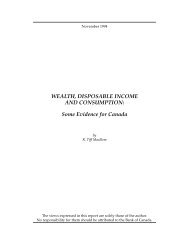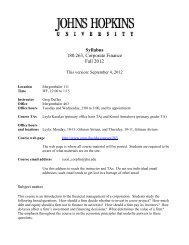Packet - Economics - Johns Hopkins University
Packet - Economics - Johns Hopkins University
Packet - Economics - Johns Hopkins University
Create successful ePaper yourself
Turn your PDF publications into a flip-book with our unique Google optimized e-Paper software.
Strategic Benefit Design and Drug Prices in Medicare Part D<br />
Colleen Carey<br />
Government Payments and Insurer Benefit Design in Medicare Part D (JMP)<br />
This paper demonstrates health insurers’ incentive to design benefits that differentially appeal<br />
to good risks (the healthy) and deter bad risks (the sick) in Medicare Part D. I extend<br />
prior theory to show that insurers in Part D will cover drugs taken by good risks at high rates<br />
and low copays while covering drugs taken by bad risks at low rates and high copays. Empirical<br />
support for benefit design theory has been lacking due to several econometric challenges, but<br />
special features of Medicare Part D allow me to verify the theoretical predictions. Most importantly,<br />
inaccuracies in Part D’s system of diagnosis-specific payments, which was set using<br />
inaccurate data, define certain diagnoses as good or bad risks. Secondly, because drugs are<br />
closely associated with diagnoses, a Part D insurer’s incentives for a particular drug can be<br />
inferred from the risk type of the diagnosis the drug treats. Finally, insurer incentives should<br />
be strong in Part D because Medicare beneficiaries with highly persistent drug needs choose<br />
plans on the basis of coverage and copay for certain drugs. Using the risk types implied by<br />
the payment system, I show that, consistent with the theory, Part D insurers cover drugs that<br />
treat good risks at higher rates and lower copayments than drugs that treat bad risks. This<br />
effect is strong even for drugs subject to special benefit design regulations.<br />
Drug Price, Bargaining Power, and Risk Type in Medicare Part D (in progress)<br />
According to prior theoretical and empirical evidence, health insurers cover services that<br />
appeal to good risks (the healthy) at high rates and low copays while covering services that<br />
appeal to bad risks (the sick) at low rates and high copays. This paper incorporates an<br />
upstream medical provider from whom the insurer must purchase services at a price set by<br />
Nash bargaining. In this setting, providers of a service that appeals to good risks demand<br />
higher prices while providers of a service that appeals to bad risks accept lower prices. When<br />
provider bargaining power is high, the reaction of service price to risk type is strong, whereas<br />
weak providers lead to a weaker relationship between risk type and service price. I test these<br />
theoretical predictions using Medicare Part D. As in previous work, the risk type of each drug<br />
is derived from Part D’s inaccurate diagnosis-specific payment system.<br />
From the Peaks to the Valleys: Cross-State Evidence on Income Volatility<br />
Over the Business Cycle (joint with Stephen Shore, forthcoming in ReSTAT)<br />
Counter-cyclical variation in idiosyncratic labor income risk could generate substantial<br />
welfare costs. Following past research, we infer income volatility – the variance of permanent<br />
income shocks, a standard proxy for income risk – from the rate at which cross-sectional<br />
variances of income rise over the life-cycle for a given cohort. Our novelty lies in exploiting<br />
cross-state variation in state economic conditions or state sensitivity to national economic<br />
conditions. We find that income volatility is higher in good state times than bad; during good<br />
national times, we find higher volatility in states more sensitive to national conditions.




